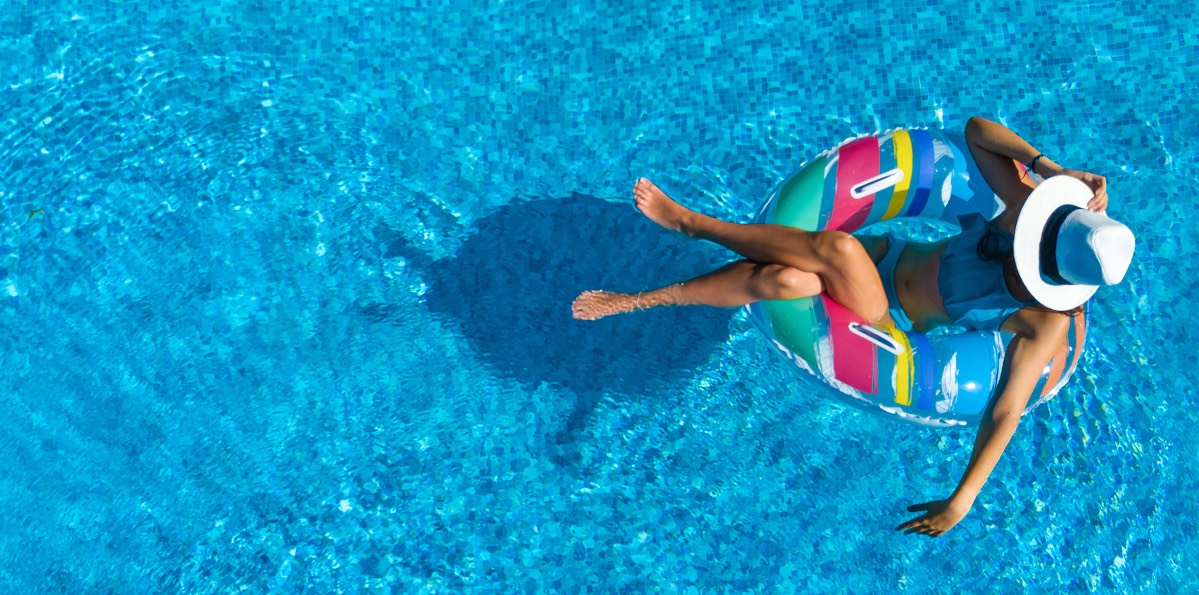While swimming is one of the best exercises you can do when you have IC and/or pelvic pain, think twice before using a hotel swimming pool or spa. The US Centers for Disease Control released a startling new research study that tracked infections and chemical trauma from swimming pools from 2000 to 2014. There were 493 outbreaks associated with treated pool water that resulted in more than 27,000 illnesses and eight deaths, according to the Morbidity and Mortality Weekly report(1). Hotel pools and hot tubs accounted for 32% of those outbreaks with others linked to public parks (23%), clubs (14%) and water parks (11%).
Parasitic infections caused the majority of pool related illnesses, the culprit usually Cryptosporidium, a parasite that can cause severe gastrointestinal problems and is resistant to chlorine treatment. A wide variety of bacteria were found with Legionella (aka Legionnaire’s disease) causing the most severe illnesses and, sadly, fatalities. If you or your child developed ear infection or a hot tub rash, Pseudomonas was the likely cause. E-coli, a common pathogen in UTI, was found in a small number of cases as well as Staphylococcus infection.
Ever wonder how the Norovirus spreads so rapidly on cruise ships? It could be from the common swimming pools and water features. This study found both Norovirus and Echovirus in some outbreaks.
Poor pool chemistry is another key issue with 1,028 people who were affected by excess chlorine, altered pool chemistry and/or disinfection by products. A 2014 CDC report in 2012 found that more than 4800 people went to the emergency room due to injuries caused by pool chemicals(2). I did! My bladder pain began after swimming in a pool which forgot to close the pool after using their annual disinfectant “shock treatment.” I’ve found a few dozen IC patients in the past 20 years who also reported that their symptoms also began after a pool or hot tub chemical treatment.
Ten Pool Safety Tips For IC/BPS patients!
#1 – Never swallow pool water! Tell your kids too!
#2 – Look at the water. Is it clear or cloudy? Blue or Green? – If the water is cloudy and/or has a greenish tinge to it, the pool may be improperly treated. Take note of any leaves or other solids sitting at the bottom of the pool? Is algae growing on the sides? These all point to a pool that may not have been properly maintained! (3) Ask when was the pool last treated. If it was treated that day, ask if a “shock treatment” was done. Ask what the proper waiting period is until the water is safe. Also, if you’re swimming in a neighbors pool, it’s worth asking who is responsible for it. A pool company, for example, might be more reliable than someone who has no experience working with chemicals.
#3 – Check the inspection scores for any public, hotel or club pool or hot tub you are hoping to swim in. In 2013, 20% of routine inspections of public hot tubs and spas found improper pool chemical concentrations. Most public pools post their inspection scores near the entrance. If they are not posted, ask for a copy of their inspection scores.
#4 – Check the pool chemical levels yourself. You can receive a free chlorine and pH test strips from the Water Quality and Health Council. If levels aren’t safe, then don’t swim. No exceptions!
#5 – If it’s your private pool, ask your guests to rinse off in the shower before entering the pool to remove excess bacteria from the skin and, err, your privates! You know what I mean!
#6 – Don’t let children (or adults) with diarrhea in the water. Yeah, really, just don’t. If you or your child has been diagnosed with cryptosporidium, you should not enter a pool for two weeks.(4)
#7 – Use the restroom immediately after leaving the pool to empty your bladder.
#8 – Quickly shower to remove all pool chemicals (and pool bacteria, etc.) from your skin.
#9 – Don’t sunbathe in a wet swimsuit. Change to a dry suit instead!
#10 – Chlorine sensitive? You could try swimming in a pool that uses bromine or even saltwater. You may or may not like it better. As always, it’s very individual!
References:
- Hlavsa MC, Cikesh BL, Roberts VA, et al. Outbreaks Associated with Treated Recreational Water — United States, 2000–2014. MMWR Morb Mortal Wkly Rep 2018;67:547–551. DOI: http://dx.doi.org/10.15585/mmwr.mm6719a3.
- Wiant C. POOL CHEMICAL SAFETY: THERE’S NO SUBSTITUTE FOR VIGILANCE. Water Quality & Health Council. July 7, 2017. https://waterandhealth.org/healthy-pools/pool-chemical-safety-theres-no-substitute-vigilance/
- Osborne J. Swimming and Interstitial Cystitis – Is it safe? IC Network Blog. June 4, 2014.
- Scutti S. Parasites and bacteria may be lurking in hotel pools, hot tubs, CDC warns. CNN. May 17, 2018 https://www.cnn.com/2018/05/17/health/crypto-bacteria-swimming-pools-hot-tubs-cdc/index.html

